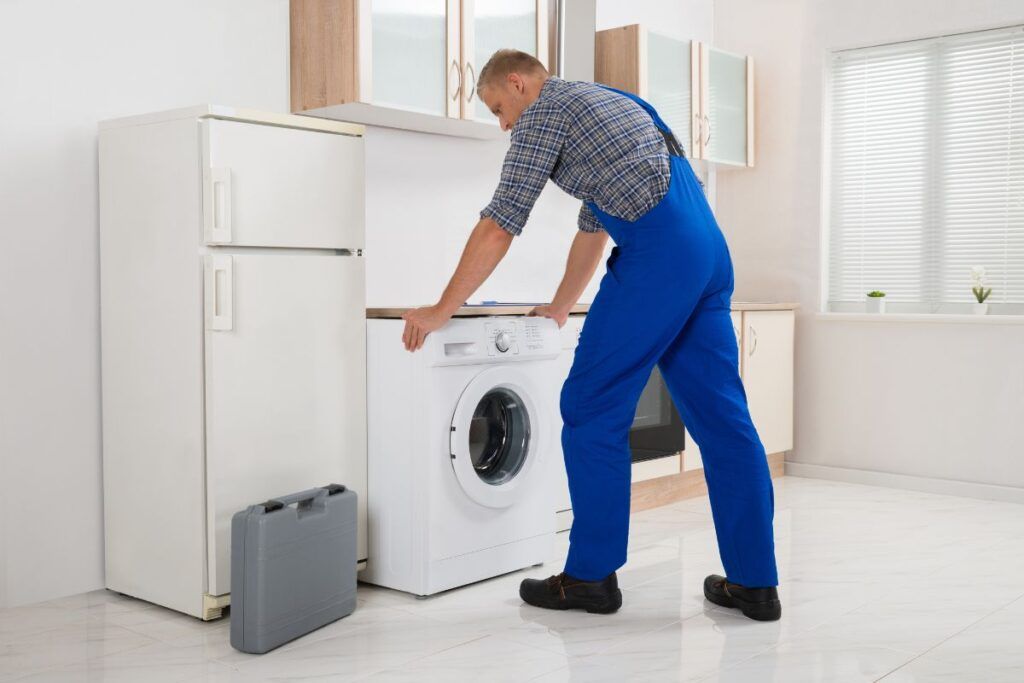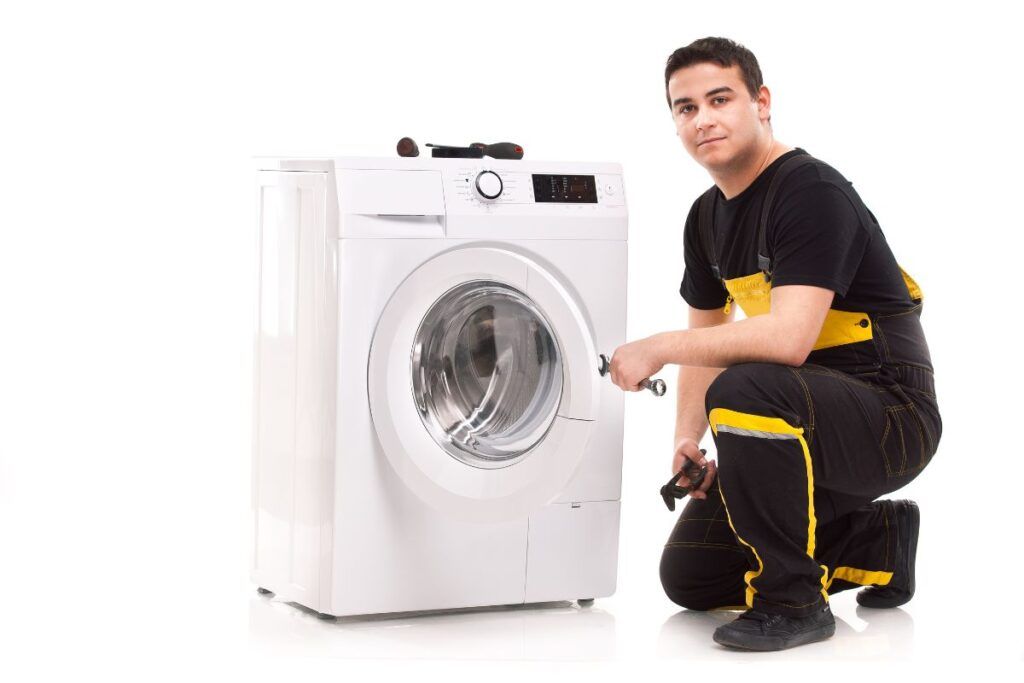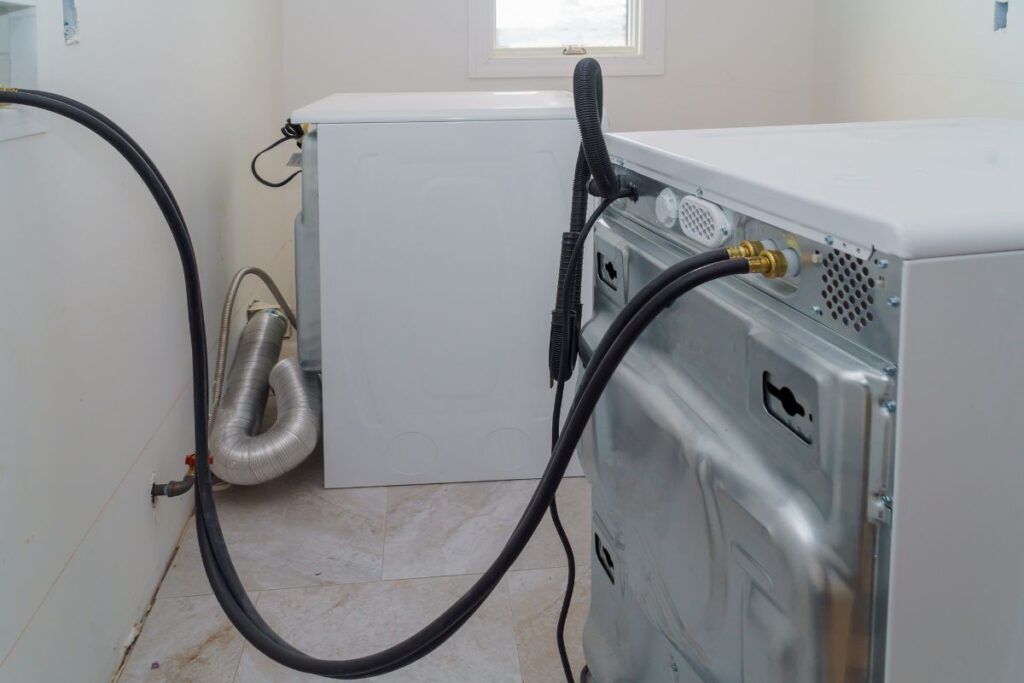Error codes are alphanumeric units to communicate faults in your Samsung washing machine. You are at the right place if you want to know the common error codes and how you can fix them.
The error code ND indicates draining issues in your washer. To fix this, check the drain hose and filter and unclog the drain hose/filter to clear the error code. A TE error code occurs due to heating issues. You can fix this by resetting the washer or replacing the temperature sensor.
| Error codes | Description |
|---|---|
| ND | Water drainage issues. |
| tE | Temperature sensor issue/Washing machine overheating. |
| OE | The washer is overfilling/overflowing. |
| 1E | The washer can’t gain water from the hose pipes. |
| UB | The washer/load is off-balanced. |
Check out our list of top-handpicked products for all your electrical, appliance, and HVAC system needs to keep your home running smoothly.
This post includes some affiliate links.In this article, you will find steps to fix 5 common Samsung error codes in detail. So, keep reading.

What are the common Samsung washing machine error codes? (+Quick fix)
Modern Samsung washing machine, unlike old models, comes with an advanced display and touch panel to make the operation easy.
It also displays error codes in the control panel to indicate the faults in the washer.
While error codes help figure out the faults and fix the issues, it will be frustrating to see the error codes while the washing cycle is running.
Isn’t it?
When an error code appears on the control panel, you don’t want to panic as you can fix it easily, provided you know what a particular error code stands for.
I have explained the 5 common error codes and the easy steps to fix them.
Shall we get started?
1. Error code ND
Error code ND in the Samsung washing machine appears when drainage system issues arise.
Drainage system issues include:
- Blocked drainage filter
- Clogged drain hose
- Drain pump issues
You can fix this issue by following the steps below.
Unclog the drain hose
At the end of the draining cycle, a washer expels the water through the drain hose.
If the drain hose is clogged with dirt and debris, it won’t let the water drain, resulting in the ND error code in the Samsung washer.
You can fix this issue by unclogging the drain hose.
Follow the steps below to unclog the drain hose:
- Disconnect the power supply from the washer.
- Move your washer from the wall to access the drain hose at the back of the washer.
- Check if the drain hose is kinked and bent. Straighten it to facilitate easy water flow.
- If the drain hose is completely damaged, you must replace it with a new hose.
- You can unclog it to fix the issue if it is clogged. You can unclog the drain hose by running the vinegar solution into it. If the clog is stubborn, you can use a metal wire to unclog the drain hose.
- Reattach the drain hose to the washer and pull it back to its original position.
- Plug in your Samsung washer to the electric outlet.
Switch it on and check if the error code ND has disappeared. If the error code persists, follow the steps below to fix the issue.
Clean the drain filter
The drain filter catches the dirt particles during the drain cycle to prevent the drain pump from getting clogged.
If the drain filter is accumulated with dirt, it will revert to the water, causing drainage issues.
Follow the steps below to clean the drain filter:
- Unplug the washer from the electric outlet.
- You can locate the filter at the base of the washer.
- Disconnect the drain hose to remove the filter from the washer.
- To access the filter, you must open the washer’s door.
- Detach the filter’s cover to see if the filter is accumulated with dirt and debris.
- Twist and turn the filter to remove it from the washer.
- Wash the filter with soapy water and vinegar solution.
- Clean it with a brush to remove all dirt and debris.
- As the filter is wet, don’t attach it as it is. Dry the filter to remove all the moisture.
- After 10 minutes, reattach the filter and drain hose to the washer.
- Reattach the filter’s cover and secure it in place.
- Plug the washer into the electric outlet and check if the error has disappeared.
If the error code ND is still showing, you must seek help from a professional to check and replace the drain pump.
2. Error code tE

The error code tE occurs in the Samsung washer when heating issues arise.
It usually happens due to the faulty temperature sensor located at the back of the washer.
To fix this issue, reset the control board of the washer.
Follow the steps below to reset the control board of the Samsung washer:
- Disconnect the power supply from the washer by unplugging the power cord from the electric outlet.
- Wait for 5 to 10 minutes.
- Plug in the washer to the electric outlet after 10 minutes.
- The Control board has reset successfully.
Switch on the washer and check if the error code has disappeared.
If it has disappeared, the control panel reset has solved the issue.
Is the TE error code still displaying in the control panel?
If yes, you must run the diagnostic mode to check if the temperature sensor is faulty.
Follow the steps below the run the diagnostic mode in the Samsung washer:
- Locate the signal and extra rinse button in the control panel.
- Press and hold the buttons for 5 seconds.
- Next, hold the extra rinse button to switch on the input mode.
- Resistance if the temperature sensor is displayed on the control board.
Compare the temperature sensor with the table below.
| S.NO | TEMPERATURE | R-MAX | R-MIN |
|---|---|---|---|
| 1 | -20℃ (-4℉) | 494.3KΩ | 481.3 KΩ |
| 2 | -10℃ (14℉) | 279.1KΩ | 273.0KΩ |
| 3 | 0℃ (32℉) | 163.8KΩ | 160.6KΩ |
| 4 | 10℃ (50℉) | 99.2KΩ | 97.5KΩ |
| 5 | 20℃ (68℉) | 61.9KΩ | 61.0KΩ |
| 6 | 30℃ (86℉) | 39.8KΩ | 39.3KΩ |
| 7 | 40℃ (104℉) | 26.2KΩ | 25.9KΩ |
| 8 | 50℃ (122℉) | 17.7KΩ | 17.5KΩ |
| 9 | 60℃ (140℉) | 12.2KΩ | 12.1KΩ |
| 10 | 70℃ (158℉) | 8.6KΩ | 8.5KΩ |
| 11 | 80℃ (176℉) | 6.2KΩ | 6.1KΩ |
| 12 | 90℃ (194℉) | 4.5KΩ | 4.4KΩ |
If you find the temperature sensor is faulty at the end of the diagnostic mode, you must replace the temperature sensor.
Follow the steps below to replace the temperature sensor:
- Begin by unplugging the washer from the electric outlet.
- You can locate the temperature sensor at the bottom of the drum of the washer.
- Remove the back panel by disconnecting the screws holding the panel with the washer.
- You can locate the temperature sensor at the bottom of the drum, secured with 2 screws.
- Using a screwdriver, unscrew the screws holding the temperature sensor in place.
- And a temperature sensor is attached to the wires. Disconnect the wires to remove them completely. Disconnect the temperature sensor and discard it.
- Replace the new temperature sensor and secure it with screws and wires.
- Reattach the back panel and secure it with screws.
- Plug the washer into the electric outlet and check if the error code tE has disappeared.
3. Error code OE
The OE error code in the Samsung washer indicated the overfilling water issues.
Overfilling in the Samsung washer happens due to the following reason.
- Control board issues
- Using too much detergent
- Failure of the water sensor
Follow the steps below to fix the issue:
Reset the control panel to clear the glitches
Before proceeding with serious issues, reset the control panel of the Samsung washing machine.
- Unplug the washer from the electric outlet.
- Wait for 5 to 10 minutes.
- Replug the washer with the electric outlet after 10 minutes.
If the control panel glitches are causing the error code, after a reset, the error code OE will disappear.
Check if you are using too much detergent.
Using low-quality detergent in a highly efficient washer can cause issues with the washer.
If you use excess detergent, suds will be produced, causing the washing machine to overflow.
The excess suds creates pressure in the pressure switch.
It passes the false overflow signal to the sensor, resulting in the OE error code.
To fix the issue, initiate the spin mode and let the water drain by pressing the drain button.
Unload the clothes from the washer and initiate the rinse mode to remove the excess suds settled in the washing machine’s drum.
Unplug the washer, plug it back, and check if the error code has disappeared.
Check the water sensor for faults.
A water sensor detects when the desired water reaches and stops the water flow.
If the water sensor is faulty, overfilling occurs, and an OE error appears in the control panel.
Follow the steps below to replace the water sensor:
- Unplug the washer from the electric outlet.
- Move the washer from its original position to access the back panel.
- You can locate the water level sensor on the back side of the washer.
- You need to remove the back cover and rear access panel to access it.
- Using a Phillips screwdriver, remove the Phillips screws securing the back cover. Push the cover to detach it from the washer.
- Tilt the control panel forward by removing two screws holding it in place.
- Disconnect the rear access panel by removing four screws and securing it.
- You can locate the water level sensor tubes at the left upper corner connecting with the sensor at the top. You must release the tubs from the tabs to remove the water sensor.
- Access the water sensor at the top of the washer near the control panel.
- Replace it with the new one and secure the tubes with the tabs.
- Reattach the back cover and rear access panel.
- Plug in the washer and check if the OE error has disappeared.
4. Error code 1E

1E error code appears in the washer when it can’t gain water from the hose pipes.
If the water doesn’t flow in the washer, it can’t initiate the washing cycle, resulting in the 1E error code.
The causes of the 1E error codes are a clogged drain hose or the drain hose not fitted with the washer tight.
To fix this issue, you must unclog the drain hose by following the steps mentioned in error code 1.
Check if the drain hose is loosely connected and leaking water.
Follow the steps below to tighten the drain hose:
- Unplug the washer from the electric outlet.
- Move it from its original position to access the drain hose.
- Using a wrench, detach the hose and check it for any damages.
- If it is damaged, replace the drain hose.
- Or else fit it in the water supply line. Tighten it using a wrench.
- Plug in the washer and start the washing cycle.
- If the water flows, the 1E error code will stop showing on display.
- Another cause of this issue is the failure of the water level sensor. Follow the steps mentioned in error code 3 to replace the faulty water level sensor.
5. Error code UB
The UB error code in the Samsung washer occurs when your washer is in an off-balanced load.
Here are the common causes of the error code UB on the Samsung washer:
- The clothes in the tub are tangled and clumsy.
- The washer is placed on an unlevelled surface.
- You have overloaded the washer.
- You have started the washing cycle with fewer items.
You can fix this issue by balancing the load and placing the washer on the leveled surface.
Follow the steps below to fix the issue:
Untangle the clothes
If the washer is stuck amid the washing cycle displaying the error code UB, you must pause the cycle and follow the instructions below.
Manually untangle the clothes and take out some clothes if you have overloaded the washer.
As Samsung washing machines are designed to set specific washing cycles based on the fabrics of clothes, you must set the right washing clothes based on the clothes you are loading.
Reset your washing machine
If the error code UB persists after balancing the load, try resetting the washer to clear the glitches in the control panel.
Unplug the washer from the electric outlet and wait for 5 to 10 minutes.
Replug it into the electric outlet and check if the error code has disappeared.
If control panel glitches are causing the error codes, resetting the washer will solve the issue.
If the error code appears back, you must check if your washer is placed on the leveled surface.
Check the surface where your washer is placed.
If your washer is placed on a bumpy surface, it will become off-balanced, resulting in the UB error code.
You can fix it by moving the washer to another place or adjusting the washer’s leg.
You can adjust the washer’s leg using a wrench.
Turn it clockwise to move it down and anticlockwise to move it up.
After adjusting the leg, secure the washer’s leg with the locking nuts.
If you decide to move your washer to a new location, ensure the surface is not so smooth or slippery.
After leveling the surface, check if the error UB has disappeared.
Also read: 6 Reasons Your Washing Machine Is Off Balance (+Fix)
Final thoughts
Error codes commonly occur in the washer now and then. So, you don’t have to be scared or worry about the cost of repair. Most of the time, a simple repair can fix the issue, which you can do yourself.
However, if a complex problem occurs, you must seek a professional’s advice. In the article, I have discussed common Samsung ND, TE, OE, IE, and UB error codes. And also, there are steps to fix the error code. Go through the causes and follow the steps to fix the error codes.
Reference: Samsung Official Error Codes.



